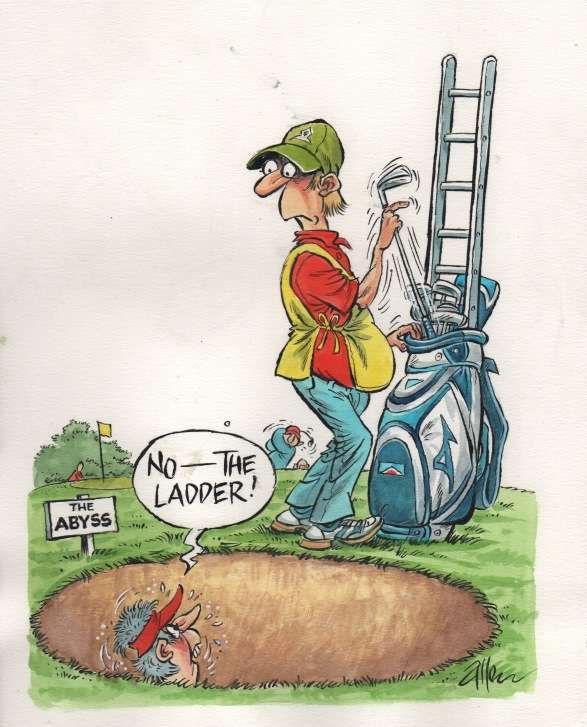Features
Johnson column: The playable bunkers of today are no longer a sandy abyss

It was all a little embarrassing, to tell the truth. When Mrs J walked through the door to find me blubbing uncontrollably in front of the TV, the sitting room carpet was awash with enough moisture to have been designated a natural water hazard and cordoned off with yellow stakes.
“Good Lord, what have you been watching?” she inquired. “Has Forrest Gump been on again?”
“No, no,” I managed to gulp out in a brief moment of remission before being wracked by another bout of helpless sobbing. “It’s far more of a weepie than that. It’s the Volvo China Open.”
I’m bound to say that I don’t normally get through half a dozen boxes of Kleenex watching some faraway golf tournament awash with non-household names, but I’d be mildly surprised if I was the only one who came over all emotional during Sky’s third-day coverage on Saturday. Specifically when one of the commentators asked his sidekick: “Is there anyone to blame for the fact that we’re seeing so many plugged lies in the bunkers?”
To which his chum replied: “It happens a lot at new venues. A little tip. Hose them down the week before like they do at Augusta National. It’s very frustrating for the guys.”
A sadder story I’ve never come across; no wonder I lost it there for a while.
Ye gods. You wonder what Peter Alliss would have made of it.There might be one or two of you out there who believe that Alliss now belongs behind a glass cabinet in a golf museum, sitting in a rocking chair alongside a selection of hickory shafted clubs and gutta percha balls, but at least he would have come up with the appropriate reply. Something along the lines of: “Call me an old fuddy duddy, but when I was playing bunkers were usually described as hazards.”
Instead, we got some apologist for the modern generation of pampered pros suggesting that the head greenkeeper was a club short of a full set for ordering sand that was clearly only suitable for a kiddies’ play pen. Instead of the crushed marble type stuff that even duffers like me can get up and down from, as I once discovered during a British Masters pro-am. I even got some backspin, and to this day, when a pro golfer splashes out to a couple of inches from a routine lie in a greenside bunker, I’m so gobsmacked by the miraculous skill involved that it’s all I can do to stifle a yawn.
There are no golf courses left on the European Tour, or none that I can think of, where the bunkers constitute hazards. The next time you witness such a venue on your TV screen will be in July, during the Open at Royal Troon. Where, just like at St Andrews, the bunkers are the combined work of nature and Beelzebub.
There are 112 bunkers on the Old Course, and the fact that none of them received a visit from Tiger Woods when he won the 2000 Open there is one of the more remarkable statistics in Open history. They’ve all got names, and their very nature means that they’re not called Bondi, Ipanema or Copacabana. Welcome instead to Hell, the Coffins, and the Beardies.
If the main reason for being unable to make legitimate comparisons between golfers of different eras is equipment – the old Ryder Cup player Maurice Bembridge once told me that in every box of 12 balls he opened he was delighted if he managed to find two that were round – then playing conditions, including easy to get out of bunkers, come a close second.
I remember watching Sam Snead on one of those Shell’s Wonderful World Of Golf programmes hitting his drive down what appeared to be a farmer’s field, then watching his putt bounce along like a World War One Sopwith Camel taking off. And the bunkers looked as though they’d just hosted the Horse of the Year Show.
Listen to the commentary on a modern pro golf tournament and you will almost certainly hear at some stage: “That’s a good place to miss it – in the greenside bunker.” Quite often, depending on where the pin is, or the height of the rough, the bunker is the place to actually aim for.
You don’t see people aiming for bunkers at Troon, or St Andrews, or on that gem of a links course near Wicklow in Ireland, The European.
When the genial proprietor Pat Ruddy hands you your scorecard, there’s a little message on the back, largely for the benefit of visiting Americans. “Please be aware that our bunkers are not pleasure beaches. They are places of penance.”
As indeed they ought to be. The most famous hole in golf, the 17th on the Old Course, also contains the most legendary hazard in golf, the Road Bunker.
After the 1984 Open it was briefly known as the “Sands of Nakajima”, after the Japanese golfer of that name first putted into it, and then re-enacted the Hamlet cigar advertisement trying to get out. Resulting in a five-over-par nine.
Bobby Jones would never have been able to say nowadays what was true back in his day, namely that “too much ambition is a bad thing to have in a bunker”.
Neither would the most celebrated golf writer of them all, Bernard Darwin, be able to pen that memorable line about a pot bunker having “just enough room for an angry man and his niblick”.
When you descend into the dark and murky depths of a proper links bunker, your first thought is whether you’ll ever get your ball out, and your second is whether you’ll ever get yourself out.
“Hand me the rake, caddie.”
“It’s all right sir, I’ll smooth out your footprints.”
“I don’t think you quite understand. I need to grab hold of it while you pull me out of here.”
But in regular European Tour events, bunkers are just one more thing for the pros to moan about if they’re not perfect.
The rough is too tough, the pins are in the wrong place, the weather’s too hot, the weather’s too cold, the wind’s too windy, the gallery’s too noisy.
These chaps are quite capable of doing their own whingeing thanks very much, so when television commentators start doing it for them, no wonder it makes you burst into tears.
Tagged European Tour








